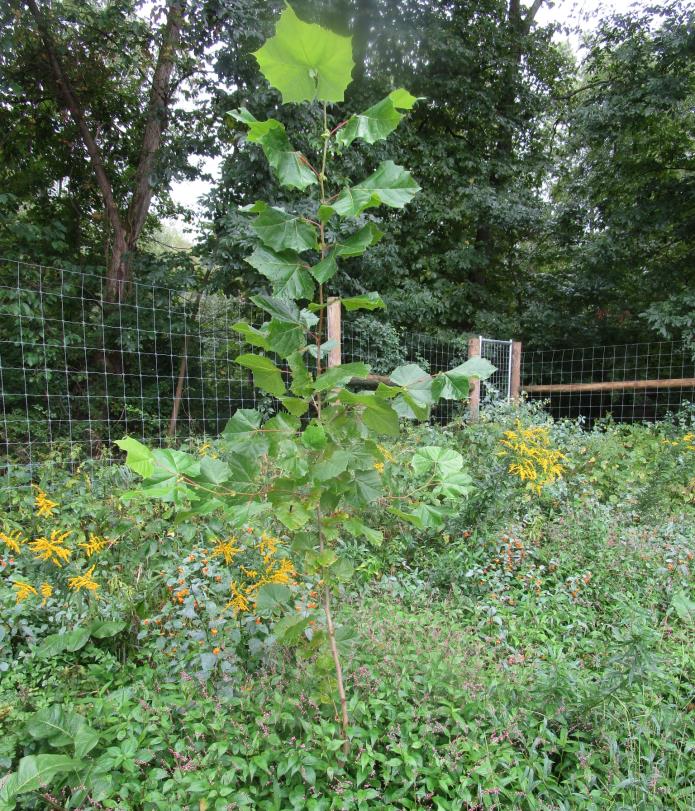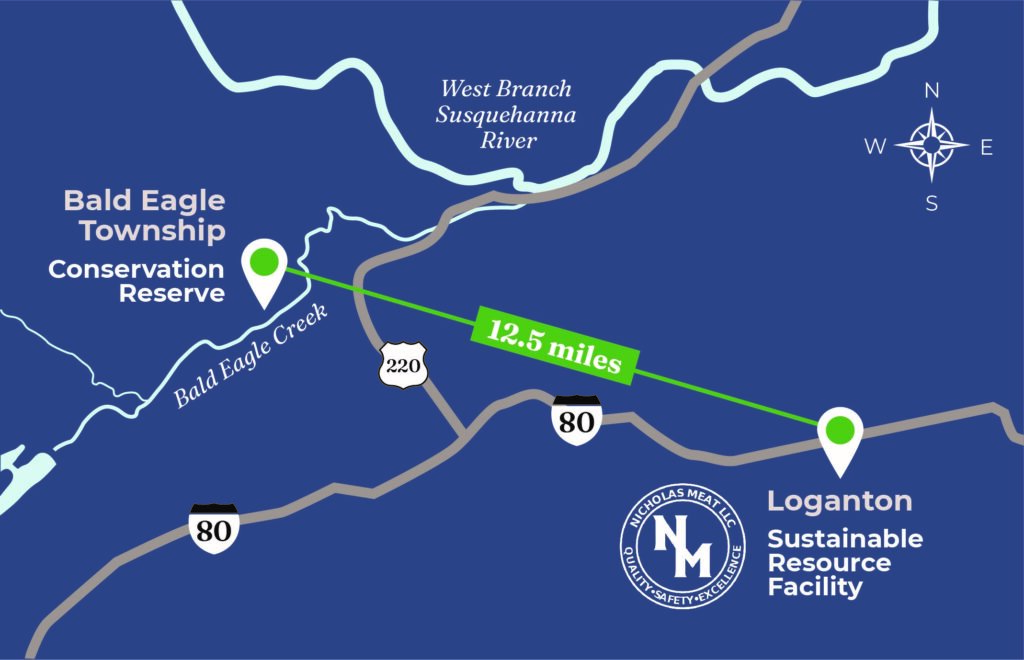One Year In – Conservation Reserve Makes Headway
November 3, 2022
November 3, 2022
Despite the summer drought conditions, the Nicholas Meat Conservation Reserve is growing and thriving. Completed in October 2021, the site is located in the 100-year floodway of Bald Eagle creek in Bald Eagle Township, Clinton County. The reserve totals more than 12 acres and is home to almost 2,500 trees and a wide variety of native wetland grasses.
With the Sustainable Resource Facility (SRF) construction along Route 880 near Loganton, the Reserve was built as compensation for the forested riparian buffer and watercourse impacts that occurred due to land development needed for the SRF. This new conservation site is protected with a conservation covenant that will remain with the land perpetually.

“Considering the conditions we’ve had this year, the Conservation Reserve is doing very well,” said Steve Bason, professional wetland scientist, Cedar Run Environmental Services, Inc. “It’s not unanticipated for a wetland reserve like this to take a little while to get going. Once we get back to normal rains, I think this reserve will do really, really well.”
Tree Survival Rate
Bason, who monitors the reserve bi-annually for Nicholas Meat, said the trees planted last year had an 86 percent survival rate. Those trees that did not survive were replaced in October 2022 with primarily Sycamore trees to ensure a survival rate of almost 100 percent.
“A survival rate of 86 percent is pretty good when you consider we had a gypsy moth outbreak, plus the drought,” Bason explained. “And, you’re taking trees grown and cared for in a nursery – i.e., ideal conditions – and planting them in the wild. Considering this scenario, the trees did quite well.”
A diverse mix of tree species was selected to address the planting conditions in the Reserve, which consists of a combination of wetlands and uplands. The wetter species, including swamp white oak, pin oak, black willow, silver maple, and American sycamore, were concentrated in the wetland areas. The upland species, including big-tooth aspen, American basswood, shagbark hickory, red oak, black walnut, and black cherry, were concentrated in the higher, drier portions of the site.
“Replacing those lost with sycamores is ideal as the sycamore is a great tree,” Bason added. “Deer don’t like it. Gypsy moths don’t like it. It grows like crazy and it’s native. It belongs on that valley floor.”
The Conservation Reserve is fenced to protect newly planted trees and vegetation from deer and other wildlife like black bears. Also, hundreds of natural tree seedlings have come up on the property.
Grasses Getting Slow Start
Before trees were planted, the newly created wetlands were seeded with Annual Ryegrass and a wetland seed mix that includes various sedges, arrow wood, gray dogwood, silky dogwood, buttonbush, and meadow sweet.
“When you look at the site today, you’ll see weeds growing, but that’s due to the drought,” Bason said. “We haven’t been in there mowing or weed whacking, so weed seeds have had an opportunity to go unchecked. Once we return to normal rains, Mother Nature will kick in and the wetland plants will begin to grow.”

Defining a Forested Riparian Buffer
According to the Natural Resources Conservation Service (NRCS), “Riparian areas are lands that occur along watercourses and water bodies. Typical examples include floodplains and streambanks. They are distinctly different from surrounding lands because of the unique soil and vegetation characteristics strongly influenced by water.”[i]
USDA’s National Agroforestry Center further explains that forested riparian buffers “can deliver a number of benefits including filtering nutrients, pesticides, and animal waste from agricultural land runoff; stabilizing eroding banks; filtering sediment from runoff; providing shade, shelter, and food for fish and other aquatic organisms; providing wildlife habitat and corridors for terrestrial organisms; protecting cropland and downstream communities from flood damage; producing income from farmland that is frequently flooded or has poor yields; providing space for recreation; and diversifying landowner income.”[ii]
Why Wetlands are Important
Wetlands have long been known as productive ecosystems that are often compared to rain forests and coral reefs. This environment can be home to various microbes, plants, insects, birds, fish, and mammals. According to the U.S. Environmental Protection Agency, “The combination of shallow water, high levels of nutrients and primary productivity are ideal for the development of organisms that form the base of the food web and feed many species of fish, amphibians, shellfish and insects. Many birds and mammals rely on wetlands for food, water and shelter, especially during migration and breeding. Climate, landscape shape (topology), geology and the movement and abundance of water help to determine the plants and animals that inhabit each wetland. The complex, dynamic relationships among the organisms inhabiting the wetland environment are called food webs.”[iii]
[i] https://www.nrcs.usda.gov/wps/portal/nrcs/detail/national/technical/?cid=nrcs143_014199
[ii] https://www.fs.usda.gov/nac/practices/riparian-forest-buffers.php#:~:text=Riparian%20forest%20buffers%20can%20deliver%20a%20number%20benefits,is%20frequently%20flooded%20or%20has%20poor%20yields%20
[iii] https://www.epa.gov/wetlands/why-are-wetlands-important
Photos by Steve Bason, professional wetland scientist, Cedar Run Environmental Services, Inc.